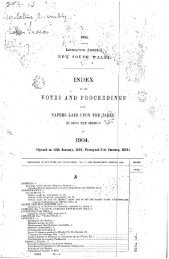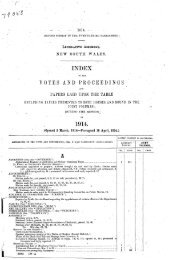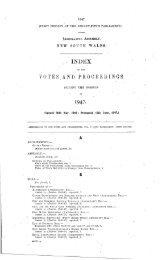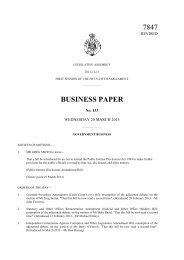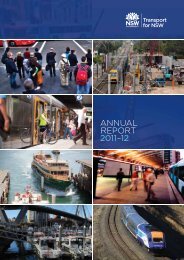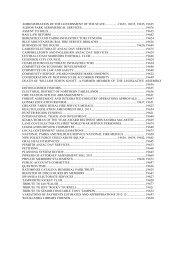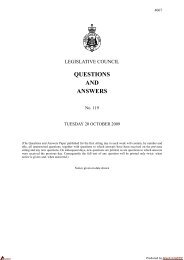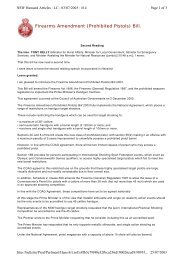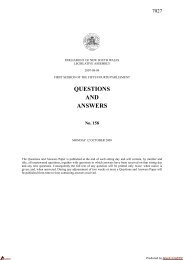Endeavour Energy Annual Performance Report - Parliament of New ...
Endeavour Energy Annual Performance Report - Parliament of New ...
Endeavour Energy Annual Performance Report - Parliament of New ...
You also want an ePaper? Increase the reach of your titles
YUMPU automatically turns print PDFs into web optimized ePapers that Google loves.
03<br />
OUR<br />
OPERATIONS<br />
A sAFe, relIAble and eFFICIent network<br />
Solar feed in tariff scheme<br />
On 1 January 2010 the NSW<br />
Government introduced the Solar<br />
Bonus Scheme to implement a 60<br />
cent per kWh feed-in tariff for ro<strong>of</strong><br />
top photovoltaic (PV) systems and<br />
wind turbines up to a maximum<br />
<strong>of</strong> 10 kW.<br />
In creating the Solar Bonus Scheme<br />
the Government had a number <strong>of</strong><br />
objectives including encouraging<br />
and supporting those who want<br />
to generate renewable energy as<br />
a response to climate change and<br />
to increase public exposure to<br />
renewable energy technology to<br />
encourage the whole community<br />
to respond to climate change.<br />
The Scheme was limited to<br />
customers with an annual electricity<br />
usage <strong>of</strong> less than 160 MWh. For<br />
eligible small retail customers, this<br />
feed-in tariff was credited on a gross<br />
metered basis.<br />
The credit is paid by distributor<br />
businesses to customers via their<br />
retailers. The recovery <strong>of</strong> the costs<br />
associated with the Solar Bonus<br />
Scheme commenced on 1 July 2011.<br />
The Scheme rapidly gained interest<br />
from the public leading to higher<br />
than expected subscription to it<br />
and ultimately resulting in changes<br />
to the Scheme on 27 October<br />
2010 following the outcomes <strong>of</strong><br />
a review <strong>of</strong> the Scheme’s first six<br />
months <strong>of</strong> operation. Two <strong>of</strong> the<br />
primary changes to the Scheme<br />
were the cessation <strong>of</strong> the previous<br />
60c per kWh rebate to be replaced<br />
by a 20c per kWh rebate, and the<br />
introduction <strong>of</strong> a target ‘cap’ for<br />
NSW <strong>of</strong> 300MW <strong>of</strong> small scale solar<br />
PV generation capacity. The revised<br />
Solar customers connected<br />
Scheme provided for the Minister for<br />
<strong>Energy</strong> to close the Scheme to new<br />
entrants once the ’cap’ <strong>of</strong> 300MW<br />
<strong>of</strong> generation capacity was installed<br />
and connected to the energy grid.<br />
On 1 July 2011, the Minister, by way<br />
<strong>of</strong> notice in the Gazette, closed the<br />
NSW Solar Bonus Scheme, citing<br />
that 300MW <strong>of</strong> small scale solar PV<br />
had been installed and connected<br />
in NSW.<br />
The Government also provided<br />
transitional amendments to<br />
the Electricity Supply (General)<br />
Regulation that allowed customers<br />
who had made an application prior<br />
to 29 April 2011 to continue to<br />
connect a generator and receive the<br />
Solar Bonus Rebate notwithstanding<br />
the closure <strong>of</strong> the Scheme.<br />
The Government has also asked the<br />
Independent Pricing and Regulatory<br />
Tribunal (IPART) to review certain<br />
actions to manage costs arising<br />
from the installation <strong>of</strong> small scale<br />
generators and their impact on<br />
electricity prices and taxpayers,<br />
while continuing to support a<br />
sustainable renewable energy<br />
industry in NSW.<br />
Following the conclusion <strong>of</strong> this<br />
review, <strong>Endeavour</strong> <strong>Energy</strong> expects<br />
that minor administrative and<br />
implementation issues will need to<br />
be addressed.<br />
<strong>Endeavour</strong> <strong>Energy</strong> has absorbed<br />
the substantial implementation and<br />
administration operating costs <strong>of</strong> the<br />
Scheme. As at 30 June 2011, these<br />
costs are estimated to approach<br />
$3.9 million over the life <strong>of</strong> the<br />
Scheme. These costs will be funded<br />
through efficiency initiatives so<br />
customers will not be impacted by<br />
the additional costs imposed on us<br />
for administering the scheme.<br />
The table below shows the<br />
breakdown <strong>of</strong> customers currently<br />
connected and those predicted<br />
to connect as <strong>of</strong> 3 July 2011. If all<br />
customers enter the scheme as<br />
expected, a total <strong>of</strong> 47,362 customers<br />
will be involved, representing a solar<br />
generation capacity <strong>of</strong> 105.9MW.<br />
In response to defects identified<br />
as a result <strong>of</strong> the Department <strong>of</strong><br />
Fair Trading inspection regime<br />
on existing solar installations,<br />
<strong>Endeavour</strong> <strong>Energy</strong> has taken the<br />
lead in developing an agreed<br />
minimum inspection regime for<br />
new solar installations by NSW<br />
electricity distributors.<br />
Demand management<br />
One way <strong>of</strong> reducing the cost<br />
<strong>of</strong> network management is to<br />
investigate demand management<br />
alternatives to network<br />
augmentation for specific capital<br />
expenditure projects.<br />
Where feasible, <strong>Endeavour</strong> <strong>Energy</strong><br />
investigates and implements<br />
projects that modify demand as an<br />
alternative to spending money to<br />
upgrade the network. Projects may<br />
include negotiating with high-use<br />
customers to move peak loads away<br />
from the network peak conditions<br />
or implementing projects to reduce<br />
overall usage in those peak times.<br />
<strong>Endeavour</strong> <strong>Energy</strong> recognises there<br />
is an imperative to ensure electricity<br />
is delivered reliably, and in an<br />
energy efficient and environmentally<br />
responsible manner, which is why<br />
we evaluate demand-side as well as<br />
construction options in the network<br />
planning process.<br />
60 cent per<br />
kWh rate<br />
20 cent per<br />
kWh rate<br />
Total<br />
Customers currently connected 37,294 4,712 42,006<br />
Generation capacity 84.1MW 10.0MW 94.1MW<br />
Approved customers applications yet to be connected 299 5,057 5,356<br />
Generation capacity 1.5MW 10.3MW 11.8MW<br />
24



